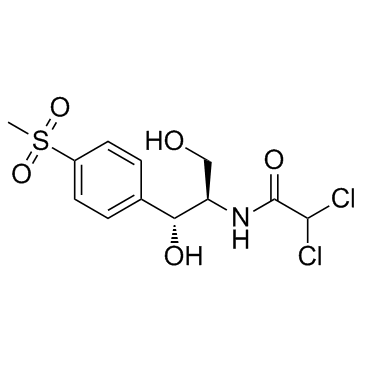Thiamphenicol

Thiamphenicol structure
|
Common Name | Thiamphenicol | ||
|---|---|---|---|---|
| CAS Number | 15318-45-3 | Molecular Weight | 356.222 | |
| Density | 1.5±0.1 g/cm3 | Boiling Point | 695.9±55.0 °C at 760 mmHg | |
| Molecular Formula | C12H15Cl2NO5S | Melting Point | 163-166ºC | |
| MSDS | Chinese USA | Flash Point | 374.7±31.5 °C | |
|
Cheminformatics analysis of assertions mined from literature that describe drug-induced liver injury in different species.
Chem. Res. Toxicol. 23 , 171-83, (2010) Drug-induced liver injury is one of the main causes of drug attrition. The ability to predict the liver effects of drug candidates from their chemical structures is critical to help guide experimental drug discovery projects toward safer medicines. In this st... |
|
|
Multiresidue method for the determination of pharmacologically active substances in egg and honey using a continuous solid-phase extraction system and gas chromatography-mass spectrometry.
Food Chem. 178 , 63-9, (2015) A sensitive, selective, efficient gas chromatography-mass spectrometry method for the simultaneous determination of 22 pharmacologically active substances (antibacterials, nonsteroidal antiinflammatories, antiseptics, antiepileptics, lipid regulators, β-block... |
|
|
Fast extraction of amphenicols residues from raw milk using novel fabric phase sorptive extraction followed by high-performance liquid chromatography-diode array detection.
Anal. Chim. Acta 855 , 41-50, (2014) A simple, sensitive, reliable, and fast analytical method was developed for the simultaneous determination of amphenicols residues in raw milk by combining fabric phase sorptive extraction (FPSE) and high-performance liquid chromatography-diode array detectio... |
|
|
Development of a phospholipidosis database and predictive quantitative structure-activity relationship (QSAR) models.
Toxicol. Mech. Methods 18 , 217-27, (2008) ABSTRACT Drug-induced phospholipidosis (PL) is a condition characterized by the accumulation of phospholipids and drug in lysosomes, and is found in a variety of tissue types. PL is frequently manifested in preclinical studies and may delay or prevent the dev... |
|
|
Functional csdA is needed for effective adaptation and initiation of growth of Clostridium botulinum ATCC 3502 at suboptimal temperature.
Int. J. Food Microbiol. 208 , 51-7, (2015) The activity of RNA helicase csdA (cbo2802) after temperature downshift was compared to its activity at optimal growth temperature, and the effect of sense and antisense oriented insertional inactivation of cbo2802 on the growth of ATCC 3502 at suboptimal tem... |
|
|
Elimination of formate production in Clostridium thermocellum.
J. Ind. Microbiol. Biotechnol. 42 , 1263-72, (2015) The ability of Clostridium thermocellum to rapidly degrade cellulose and ferment resulting hydrolysis products into ethanol makes it a promising platform organism for cellulosic biofuel production via consolidated bioprocessing. Currently, however, ethanol yi... |
|
|
High-performance thin-layer chromatography screening of multi class antibiotics in animal food by bioluminescent bioautography and electrospray ionization mass spectrometry.
J. Chromatogr. A. 1356 , 249-57, (2014) The world-wide usage and partly abuse of veterinary antibiotics resulted in a pressing need to control residues in animal-derived foods. Large-scale screening for residues of antibiotics is typically performed by microbial agar diffusion tests. This work empl... |
|
|
Validation of a streamlined multiclass, multiresidue method for determination of veterinary drug residues in bovine muscle by liquid chromatography-tandem mass spectrometry.
Anal. Bioanal. Chem 407 , 4423-35, (2015) Multiclass, multiresidue methods are becoming increasingly popular in regulatory monitoring programs due to their increased analytical scope and laboratory efficiency. In this work, we report the development and validation of a new high-throughput analytical ... |
|
|
Simultaneous detection of forbidden chemical residues in milk using dual-label time-resolved reverse competitive chemiluminescent immunoassay based on amine group functionalized surface.
PLoS ONE 9(10) , e109509, (2014) In this study, a sensitive dual-label time-resolved reverse competitive chemiluminescent immunoassay was developed for simultaneous detection of chloramphenicol (CAP) and clenbuterol (CLE) in milk. The strategy was performed based on the distinction of the ki... |
|
|
The HtrA-like protease CD3284 modulates virulence of Clostridium difficile.
Infect. Immun. 82(10) , 4222-32, (2014) In the past decade, Clostridium difficile has emerged as an important gut pathogen. Symptoms of C. difficile infection range from mild diarrhea to pseudomembranous colitis. Besides the two main virulence factors toxin A and toxin B, other virulence factors ar... |